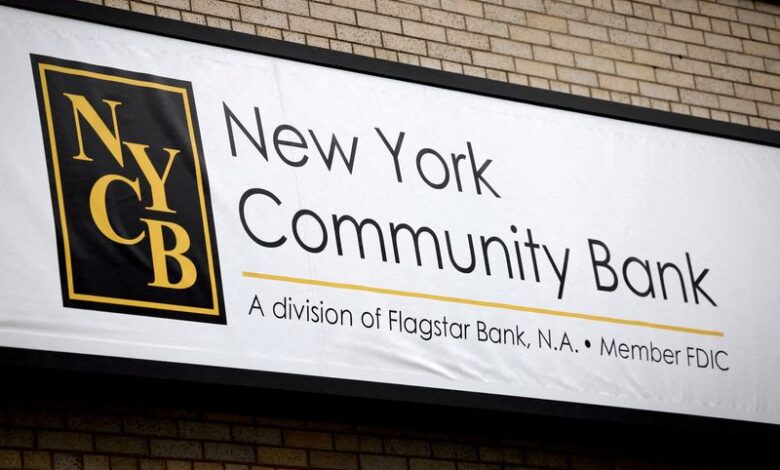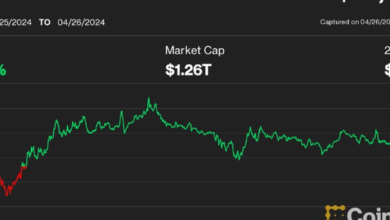NYCB faces tough choices on CRE loans, balance sheet diversification

(This April 24 story has been corrected to clarify that the bank spokesperson was referring to previous remarks by the CEO Joe Otting, in paragraph 12)
By Niket Nishant and Manya Saini
(Reuters) – New York Community Bancorp (NYSE:) will have to lure buyers for its commercial real estate (CRE) loans with steep discounts and diversify its revenue as it races to shore up its finances.
The bank’s new management has promised to unveil a turnaround plan this month after losses on CRE loans, NYCB’s core business, sparked a rout that wiped nearly $6 billion off its market value and sparked ratings downgrades.
A $1 billion investment led by former U.S. Treasury Secretary Steven Mnuchin’s Liberty Strategic Capital has shored up the bank for the short-term, but it still needs to bolster its capital and shrink its exposure to the CRE sector, which has been hammered by higher interest rates.
NYCB’s future depends on the new management offloading some CRE loans and diversifying its balance sheet, said half a dozen analysts and investors. But with rivals also retreating from CRE, and private equity and other institutional buyers seeking steep discounts, good deals will be hard to come by, they said.
“If you’re a hedge fund or an asset manager, you know NYCB has to sell. So, you’re going to factor that into your pricing,” said Brian Graham, co-founder of financial services investment firm Klaros Group, adding it will be difficult for the bank to find loans it can sell at a premium.
Multi-family apartment blocks comprise roughly 44% of NYCB’s loans and about half of those are on buildings with controls on how much landlords can raise rents, dimming their appeal.
Last month, the new management team, led by former Comptroller of the Currency Joseph Otting, said NYCB had sold a commercial co-operative loan at a gain and that non-bank bidders were interested in other loans, although it did not provide details.
But with interest rates now expected to remain elevated longer than previously anticipated amid sticky inflation, NYCB’s loan books will probably have to be repriced to reflect this, said Brian Mulberry, client portfolio manager at Zacks Investment Management, which holds several bank stocks.
“To attract any level of buyer interest it will necessitate bigger discounts today to offset a higher cost of refinancing in the future,” Mulberrry said, although he added that investors had mostly priced in any more potential bad news from the bank.
NYCB’s shares are down 70% since the beginning of the year, their lowest level since around 1996.
Depending on the size of the discount and how the loan is valued on the bank’s balance sheet, NYCB might have to take a loss on some CRE loans.
A spokesperson for the bank referred Reuters to remarks Otting made last month indicating he will share his strategy and provide forecasts during first-quarter earnings. The bank has yet to say when it will report as of Tuesday.
Wall Street analysts expect NYCB to report a loss, compared to a profit a year earlier.
“Investors will want a clearer picture of NYCB’s underlying credit quality and capital adequacy while determining future earnings power,” said Michael Ashley Schulman, chief investment officer at multifamily office Running Point Capital.
DIVERSIFICATION PUSH
Non-performing CRE loans as a percentage of U.S. banks’ portfolios doubled to 0.81% by the end of 2023 from 0.4% a year earlier, the International Monetary Fund said this month.
Ratings agency Moody’s (NYSE:) said NYCB’s CRE concentration, which equaled about six times its tangible common equity as of Dec. 31, 2023, is the highest of the rated U.S. banks.
The involvement of private-equity buyers is helpful in stabilizing capital, but long-term uncertainties around governance and strategy remain, the ratings agency added.
NYCB will have to pull back from New York real estate – the bedrock of the 165-year-old bank’s business for five decades – and diversify into other lending and fee businesses.
While high rates have reduced short-term demand for home loans, the bank’s Flagstar mortgage business could provide greater revenue diversity when rates eventually fall, said Fitch Ratings analyst Anthony Di Tomasso.
Investors will also be looking for evidence that the bank’s existing streams of non-interest income are offsetting the CRE losses, said Mulberry. That could be by improving income elsewhere, such as from loan servicing fees or through cost savings, although the bank will also need to invest in compliance after disclosing control failures, said analysts.
Investors and analysts will focus on NYCB’s progress integrating failed Signature Bank (OTC:) assets which it acquired last year, pushing its balance sheet above a $100 billion regulatory threshold that triggered tougher capital and liquidity rules.
That deal aimed to diversify the bank away from CRE by adding $33.5 billion of deposits and roughly $11.7 billion of commercial and industry loans.
However, NYCB warned last month that the fair value of those assets could change, underscoring the ongoing uncertainty over the state of the bank’s balance sheet.
“Bank turnarounds often take years not weeks,” said Schulman.



